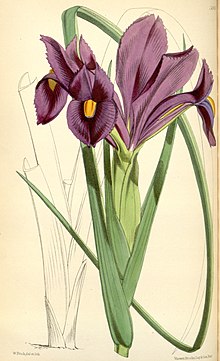| Iris filifolia | |
|---|---|

| |
| Conservation status | |
 Least Concern (IUCN 3.1) | |
| Scientific classification | |
| Kingdom: | Plantae |
| Clade: | Tracheophytes |
| Clade: | Angiosperms |
| Clade: | Monocots |
| Order: | Asparagales |
| Family: | Iridaceae |
| Genus: | Iris |
| Subgenus: | Iris subg. Xiphium |
| Section: | Iris sect. Xiphium |
| Species: | I. filifolia |
| Binomial name | |
| Iris filifolia Boiss. | |
| Synonyms | |
| |

Iris filifolia is a species in the genus Iris, it is also in the subgenus Xiphium. It is a bulbous perennial from North Africa and Europe. It has thin leaves, summer flowers in shades of red-purple.
Description
It has 3 mm wide leaves, which appear in the autumn. It normally reaches a height of 10-16 inches (or 25–40 cm). But can reach up to 45 cm tall. It flowers between March and June. Normally more than 2 flowers per stem. When the flowering shoot comes out of the ground it is covered in a purple or white blotched sheath. These then open up to revel red-purple flowers with orange spots, or yellow stripe on the falls.
Biochemistry
As most irises are diploid, having two sets of chromosomes, this can be used to identify hybrids and classification of groupings. It has a chromosome count: 2n=32.
Taxonomy
Its name means 'thread-leaved iris'.
In Gibraltar, it is also known as the 'Narrow-leaved Purple Iris'.
It is often mistakenly called 'Spanish Iris'. The Spanish Iris is Iris xiphium.
In 1842, it was first described by Pierre Edmond Boissier in 'Voyage botanique en Espagne' Vol 2, on page 602. Dykes notes that this description is incorrect. It was also described in Curtis's Botanical Magazine No.5929 as 'Xiphion filifolium'.
It was recorded in the Catalogue of Life in 2011, and it was verified by United States Department of Agriculture Agricultural Research Service on 4 April 2003, and updated on 14 November 2005.
Distribution and habitat
It is native to temperate regions of North Africa and Europe.
Range
It was found originally on Sierra de Mijas, and Sierra Bermeja in Spain, at 3,000–4,000 ft (910–1,220 m) above sea level.
It is found within Africa, in Morocco, (near Tangier,) and within Europe, in Southwestern Spain, and in Gibraltar.
Habitat
Iris filifolia likes to grow in sandy areas.
Cultivation
It is best grown in a bulb frame in the UK.
It is known to be toxic like other bulbs in the genus.
Cultivars
Several known cultivars are;
- 'A. Bloemaard' (dark blue)
- 'Filifolia'
- 'Filifolia Alba'
- 'Filifolia Elizabeth'
- 'Filifolia Imperator'
- 'Filifolia Praecox'
- 'Latifolia'
- 'Queen Of Gazelles'
- 'Rex'
Hybrids
- Iris filifolia var. latifolia (Foster) wide leaved variant
- Iris filifolia var. filifolia (Boiss) and thread-like leaved variant,
References
- Crespo, M.B. (2017). "Iris filifolia". IUCN Red List of Threatened Species. 2017: e.T13161707A65077657. doi:10.2305/IUCN.UK.2017-3.RLTS.T13161707A65077657.en. Retrieved 20 November 2021.
- ^ Roskov Y.; Kunze T.; Orrell T.; et al., eds. (2011). "Species 2000 & ITIS Catalogue of Life: 2014 Annual Checklist". Species 2000: Reading, UK. Retrieved 29 July 2014.
- ^ "(SPEC) Iris filifolia Boiss". wiki.irises.org (American Iris Society). Retrieved 29 July 2014.
- ^ James Cullen, Sabina G. Knees, H. Suzanne Cubey (Editors) The European Garden Flora Flowering Plants: A Manual for the Identification, p. 259, at Google Books
- ^ British Iris Society (1997) A Guide to Species Irises: Their Identification and Cultivation , p. 221, at Google Books
- ^ Austin, Claire (2005). Irises: A Gardener's Encyclopedia. Timber Press, Incorporated. ISBN 978-0881927306. OL 8176432M.
- "Iris filifolia Boiss". iridaceae.e-monocot.org. Archived from the original on 4 March 2016. Retrieved 21 July 2014.
- ^ "Iris summary" (PDF). pacificbulbsociety.org. 14 April 2014. Retrieved 8 February 2018.
- Ivan Nikolaevič Filipév and Jacobus Hermanus Schuurmans Stekhoven A Manual of Agricultural Helminthology, p. 284, at Google Books
- ^ Linares, Leslie L. "Gibraltar Flora". www.gibraltar.gov.gi. Retrieved 29 July 2014.
- "Iris filifolia". www.webster-dictionary.org. Retrieved 30 July 2014.
- "Iris filifolia Boiss". apps.kew.org. Retrieved 30 July 2014.
- Dykes, William R. "Dykes on Irises (Reprints of Journals)" (PDF). www.beardlessiris.org. Retrieved 30 July 2014.
- ^ "Iris filifolia". Germplasm Resources Information Network. Agricultural Research Service, United States Department of Agriculture. Retrieved 8 February 2018.
- CRESPO VILLALBA, Manuel B. (2012). "Nomenclatural Types OF Iberian Irises (Iris and Related Genera, Iridaceae)" (PDF). Retrieved 30 July 2014.
- Rosenberg, Kristin. "Flowers of Gibraltar". www.unicover.com. Archived from the original on 9 February 2018. Retrieved 29 July 2014.
- Cassidy, G.E.; Linnegar, S. (1987). Growing Irises (Revised ed.). Bromley: Christopher Helm. p. 74. ISBN 0-88192-089-4.
- "Iris filifolia - Boiss". www.pfaf.org. Retrieved 30 July 2014.
- Griffiths, David (April 1928). "Production of Certain Iris Bulbs". Retrieved 30 July 2014.
Other sources
- Fennane, M. & M. I. Tattou 1998. Catalogue des plantes vasculaires rares, menacées ou endémiques du Maroc (Bocconea) 8:205.
- Jahandiez, E. & R. Maire Catalogue des plantes du Maroc. 1931-1941 (L Maroc)
- Maire, R. C. J. E. et al. Flore de l'Afrique du Nord. 1952- (F Afr Nord)
- Mathew, B. The Iris. 1981 (Iris) 136.
- Tutin, T. G. et al., eds. Flora europaea. 1964-1980 (F Eur)
External links
![]() Media related to Iris filifolia at Wikimedia Commons
Media related to Iris filifolia at Wikimedia Commons
![]() Data related to Iris filifolia at Wikispecies
Data related to Iris filifolia at Wikispecies